Towards Urban Mining—Estimating the Potential Environmental Benefits by Applying an Alternative Construction Practice. A Case Study from Switzerland
Abstract
:1. Introduction
2. Materials and Methods
2.1. Applied Methodology
2.2. Swiss Residential Building Sector
2.2.1. Model Residential Buildings
2.2.2. Net Change of the Built Environment
2.3. LCA Framework
2.3.1. Goal and Scope Definition
2.3.2. Life Cycle Inventory (LCI) Modelling
2.3.3. Life Cycle Impact Assessment (LCIA)
- GWP (global warming potential). This indicator estimates the carbon footprint for a product or service by assessing various GHG emissions throughout their lifetime. The indicator is reported in kg of CO2 equivalents [55].
- UBP (method of ecological scarcity). The Swiss-based method of ecological scarcity (EC) assesses the total environmental impact in the context of LCA [56]. Central parameters of the method are the so-called eco-factors, which indicate the environmental impacts of a released emission or an extracted resource in the unit of “Environmental Impact Points” (in German “Umweltbelastungspunkte”, UBP) per unit of quantity. The value aggregates and assesses a variety of environmental impacts in a “true and fair” view, collectively referred to as the Ecological Footprint.
3. Results and Discussion
3.1. Model Residential Buildings
3.2. Country Level Sustainability Potential
4. Limitations
Supplementary Materials
Author Contributions
Funding
Acknowledgments
Conflicts of Interest
References
- Peter, C.; Swilling, M. Sustainable, Resource Efficient Cities—Making it Happen! UNEP (United Nations Environmental Programm): Paris, France, 2012. [Google Scholar]
- Seto, K.C.; Dhakal, S.; Bigio, A.; Blanco, H.; Delgado, G.C.; Dewar, D.; Huang, L.; Inaba, A.; Kansal, A.; Lwasa, S. Human settlements, infrastructure and spatial planning. In Climate Change; Cambridge University Press: Cambridge, UK, 2014. [Google Scholar]
- Akenji, L.; Bengtsson, M.; Briggs, E.; Chiu, A.; Daconto, G.; Fadeeva, Z.; Fotiou, S.; Gandhi, R.; Mathews, C.; Metternicht, G.; et al. Sustainable Consumption and Production: A Handbook for Policy Makers; Briggs, E., Ed.; UNEP: Nairobi, Kenya, 2015. [Google Scholar]
- Cossu, R.; Williams, I.D. Urban mining: Concepts, terminology, challenges. Waste Manag. 2015, 45, 1–3. [Google Scholar] [CrossRef] [PubMed]
- Ruby, I.; Ruby, A. Mine the city. In Re-Inventing Construction; Ruby, I., Ruby, A., Eds.; Ruby Press: Berlin, Germany, 2010; pp. 243–247. [Google Scholar]
- Hebel, D.E.; Wisniewska, M.H.; Heisel, F. Building from Waste: Recovered Materials in Architecture and Construction; Birkhäuser: Basel, Switzerland, 2014. [Google Scholar]
- Meadows, D.H.; Meadows, D.L.; Randers, J.; Behrens, W.W. The limits to growth. N. Y. 1972, 102, 27. [Google Scholar]
- Hebel, D.; Wisniewska, M.H.; Heisel, F. Constructing Waste—Investigating an alternative resource for future cities. FCL Magazine 2015, Special Issue, 56–67. [Google Scholar] [CrossRef]
- Huang, S.-L.; Hsu, W.-L. Materials flow analysis and emergy evaluation of Taipei’s urban construction. Landsc. Urban Plan. 2003, 63, 61–74. [Google Scholar] [CrossRef]
- Jacobs, J. The Death and Life of Great American Cities; Random House: New York, NY, USA, 1961. [Google Scholar]
- Weng, C.-L.; Yashiro, T. Urban Mining: The City as a Source for Re-usable Building Materials. In Proceedings of the International Conference on Open Building, Hong Kong, China, 23–26 October 2003; pp. 172–181. [Google Scholar]
- Graedel, T.E. The prospects for urban mining. Bridge 2011, 41, 43–50. [Google Scholar]
- Li, J. Wastes could be resources and cities could be mines. Waste Manag. Res. 2015, 33, 301–302. [Google Scholar] [CrossRef] [Green Version]
- European Commission; Directorate-General for Environment. Report from the Commission to the European Parliament, the Council, the European Economic and Social Committee and the Committee of the Regions on the implementation of the Circular Economy Action Plan COM 190; European Commision: Brussels, Belgium, 2019. [Google Scholar]
- Eurostat. Circular Material Use Rate—% of Total Material Use; Eurostat: Luxembourg, 2004. [Google Scholar]
- De Wit, M.; Hoogzaad, J.; Ramkumar, S.; Friedl, H.; Douma, A. The Circularity Gap Report: An Analysis of the Circular State of the Global Economy; Circle Economy: Amsterdam, The Netherlands, 2018. [Google Scholar]
- Hebel, D.; Chladek, P.; Fibicher, A.; Jorisch, P.; Heisel, F.; Nash, S.; Rufer, H.; Salis, G.; Wisniewska, M.H. Building for Disassembly, Design Studio Publication Spring 2016, 04/05; ETH: Zürich, Switzerland, 2016. [Google Scholar]
- Allwood, J.M.; Ashby, M.F.; Gutowski, T.G.; Worrell, E. Material efficiency: A white paper. Resour. Conserv. Recycl. 2011, 55, 362–381. [Google Scholar] [CrossRef]
- Arora, R.; Paterok, K.; Banerjee, A.; Saluja, M.S. Potential and relevance of urban mining in the context of sustainable cities. IIMB Manag. Rev. 2017, 29, 210–224. [Google Scholar] [CrossRef]
- Plastinina, I.; Teslyuk, L.; Dukmasova, N.; Pikalova, E. Implementation of Circular Economy Principles in Regional Solid Municipal Waste Management: The Case of Sverdlovskaya Oblast (Russian Federation). Resources 2019, 8, 90. [Google Scholar] [CrossRef] [Green Version]
- Bogner, J.; Pipatti, R.; Hashimoto, S.; Diaz, C.; Mareckova, K.; Diaz, L.; Kjeldsen, P.; Monni, S.; Faaij, A.; Qingxian, G.; et al. Mitigation of global greenhouse gas emissions from waste: Conclusions and strategies from the Intergovernmental Panel on Climate Change (IPCC) Fourth Assessment Report. Working Group III (Mitigation). Waste Manag. Res. 2008, 26, 11–32. [Google Scholar] [CrossRef]
- Derringer, J. The Manifesto House in Chile by James & Mau and Infiniski. 2010. Available online: https://design-milk.com/the-manifesto-house-in-chile-by-james-mau-and-infiniski/ (accessed on 18 August 2019).
- Urban Omnibus. Field Report: London Festival of Architecture 2010. Available online: https://urbanomnibus.net/2010/08/field-report-london-festival-of-architecture-2010/ (accessed on 18 August 2019).
- Griffiths, A. Waste House by BBM is “UK’s first permanent building made from rubbish”. 2014. Available online: https://www.dezeen.com/2014/06/19/waste-house-by-bbm-architects-is-uks-first-permanent-building-made-from-rubbish/ (accessed on 18 August 2019).
- Heisel, F.; Rau-Oberhuber, S. Calculation and evaluation of circularity indicators for the built environment using the case studies of UMAR and Madaster. J. Clean. Prod. 2020, 243, 118482. [Google Scholar] [CrossRef]
- Heisel, F.; Hebel, D.E.; Sobek, W. Resource-respectful construction—The case of the Urban Mining and Recycling unit (UMAR). IOP Conf. Ser. Earth Environ. Sci. 2019, 225, 012049. [Google Scholar] [CrossRef]
- Brunner, P.H. Urban Mining A Contribution to Reindustrializing the City. J. Ind. Ecol. 2011, 15, 339–341. [Google Scholar] [CrossRef]
- Arora, M.; Raspall, F.; Cheah, L.; Silva, A. Buildings and the circular economy: Estimating urban mining, recovery and reuse potential of building components. Resour. Conserv. Recycl. 2020, 154, 104581. [Google Scholar] [CrossRef]
- Angelis-Dimakis, A.; Holland, J. Assessing the Urban Mining Potential in the City of Huddersfield, UK. In Proceedings of the CEST 2017 15th International Conference on Environmental Science And Technology, Rhodes, Greece, 31 August–2 September 2017. [Google Scholar]
- Jones, P.T.; Geysen, D.; Tielemans, Y.; Van Passel, S.; Pontikes, Y.; Blanpain, B.; Quaghebeur, M.; Hoekstra, N. Enhanced Landfill Mining in view of multiple resource recovery: A critical review. J. Clean. Prod. 2013, 55, 45–55. [Google Scholar] [CrossRef]
- Kirchherr, J.; Reike, D.; Hekkert, M. Conceptualizing the circular economy: An analysis of 114 definitions. Resour. Conserv. Recycl. 2017, 127, 221–232. [Google Scholar] [CrossRef]
- Pomponi, F.; Moncaster, A. Circular economy for the built environment: A research framework. J. Clean. Prod. 2017, 143, 710–718. [Google Scholar] [CrossRef] [Green Version]
- Kakkos, E.; Heisel, F.; Hebel, D.E.; Hischier, R. Environmental assessment of the Urban Mining and Recycling (UMAR) unit by applying the LCA framework. IOP Conf. Ser. Earth Environ. Sci. 2019, 225, 012043. [Google Scholar] [CrossRef]
- Bundesamt für Statistik. Gebäude nach Kanton, Gebäudekategorie, Anzahl Geschosse, Anzahl Wohnungen und Bauperiode, 16.12.2016 ed.; Bundesamt für Statistik (BFS): Neuchâtel, Switzerland, 2018. [Google Scholar]
- Bundesamt für Statistik. Bau- und Wohnungswesen 2015; Bundesamt für Statistik (BFS): Neuchâtel, Switzerland, 2017; p. 32. [Google Scholar]
- Wüest & Partner. Bauabfälle in der Schweiz—Hochbau Studie 2015; Bundesamt für Umwelt (BAFU): Bern, Switerland, 2015. [Google Scholar]
- Holliger Consult. Bauteilkatalog. 2002. Available online: http://www.bauteilkatalog.ch/ch/de/Bauteilkatalog.asp (accessed on 18 August 2019).
- ISO. Environmental Management—Life Cycle Assessment—Principles and Framework; International Organization for Standardization: Geneve, Switzerland, 2006. [Google Scholar]
- DIN EN 15804. Sustainability of Construction Works–Environmental Product Declarations–Core Rules for the Product Category of Construction Products; European Committee for Standardization: Brussels, Belgium, 2012. [Google Scholar]
- SIA, M. Graue Energie von Gebäuden. In SchweizerischerIngenieur-und Architektenverein (SIA); SIA: Zürich, Switzerland, 2010. [Google Scholar]
- Ecoinvent Association. Ecoinvent Data v3.4-Recycled-Content System Model; Ecoinvent Association: Zürich, Switzerland, 2017. [Google Scholar]
- BRE. Product Category Rules for Type III Environmental Product Declaration of Construction Products to EN 15804:2012; BRE: Watford, UK, 2013; pp. 20–21. [Google Scholar]
- Wastiels, L.; Dessel, J. To Module D or not to Module D? The Relevance and Difficulties of Considering the Recycling Potential in Building LCA; Belgian Building Research Institute: Bruxelles, Belgian, 2013. [Google Scholar]
- Sartori, I.; Hestnes, A.G. Energy use in the life cycle of conventional and low-energy buildings: A review article. Energy Build. 2007, 39, 249–257. [Google Scholar] [CrossRef]
- Karimpour, M.; Belusko, M.; Xing, K.; Bruno, F. Minimising the life cycle energy of buildings: Review and analysis. Build. Environ. 2014, 73, 106–114. [Google Scholar] [CrossRef]
- Thormark, C. A low energy building in a life cycle—Its embodied energy, energy need for operation and recycling potential. Build. Environ. 2002, 37, 429–435. [Google Scholar] [CrossRef]
- Ness, A.D. The Impact of Overbuilding on People and the Planet; Cambridge Scholars Publisher: Cambridge, UK, 2019. [Google Scholar]
- Birgisdóttir, H.; Rasmussen, F.N. Introduction to LCA of Buildings; Danish Transport and Construction Agency: Copenhagen, Denmark, 2016. [Google Scholar]
- Ortiz, O.; Castells, F.; Sonnemann, G. Sustainability in the construction industry: A review of recent developments based on LCA. Constr. Build. Mater. 2009, 23, 28–39. [Google Scholar] [CrossRef]
- Ramesh, T.; Prakash, R.; Shukla, K.K. Life cycle energy analysis of buildings: An overview. Energy Build. 2010, 42, 1592–1600. [Google Scholar] [CrossRef]
- SIA, M. Raumnutzungsdaten für Energie- und Gebäudetechnik. In SchweizerischerIngenieur-und Architektenverein (SIA); SIA: Zürich, Switzerland, 2015. [Google Scholar]
- KBOB. Ökobilanzdaten im Baubereich; KBOB: Bern, Switzerland, 2014. [Google Scholar]
- Gauch, M.; Matasci, C.; Hincapié, I.; Hörler, R.; Böni, H. Material- und Energieressourcen Sowie Umweltauswirkungen der Baulichen Infrastruktur der Schweiz; Empa—Materials Science & Technology: St. Gallen, Switzerland, 2016. [Google Scholar]
- Hischier, R.; Weidema, B.; Althaus, H.-J.; Bauer, C.; Doka, G.; Dones, R.; Frischknecht, R.; Hellweg, S.; Humbert, S.; Jungbluth, N.; et al. Implementation of Life Cycle Impact Assessment Methods; Swiss Centre for Life Cycle Inventories Dübendorf: Duebendorf, Switzerland, 2009. [Google Scholar]
- Stocker, T.F.; Qin, D.; Plattner, G.-K.; Tignor, M.; Allen, S.K.; Boschung, J.; Nauels, A.; Xia, Y.; Bex, V.; Midgley, P.M. Climate Change 2013: The Physical Science Basis. Contribution of Working Group I to the Fifth Assessment Report of the Intergovernmental Panel on Climate Change; Cambridge University Press: Cambridge, UK and New York, NY, USA, 2013. [Google Scholar]
- Frischknecht, R.; Büsser Knöpfel, S. Ecological scarcity 2013—New features and its application in industry and administration—54th LCA forum, Ittigen/Berne, Switzerland, December 5, 2013. Int. J. Life Cycle Assess. 2014, 19, 1361–1366. [Google Scholar] [CrossRef]
- Geissdoerfer, M.; Savaget, P.; Bocken, N.M.P.; Hultink, E.J. The Circular Economy—A new sustainability paradigm? J. Clean. Prod. 2017, 143, 757–768. [Google Scholar] [CrossRef] [Green Version]
- Ghisellini, P.; Cialani, C.; Ulgiati, S. A review on circular economy: The expected transition to a balanced interplay of environmental and economic systems. J. Clean. Prod. 2016, 114, 11–32. [Google Scholar] [CrossRef]
- Cooper, D.R.; Gutowski, T.G. The Environmental Impacts of Reuse: A Review. J. Ind. Ecol. 2017, 21, 38–56. [Google Scholar] [CrossRef]
- Lützkendorf, T.P. Product data and building assessment—Flow of information. IOP Conf. Ser. Earth Environ. Sci. 2019, 225, 012038. [Google Scholar] [CrossRef]
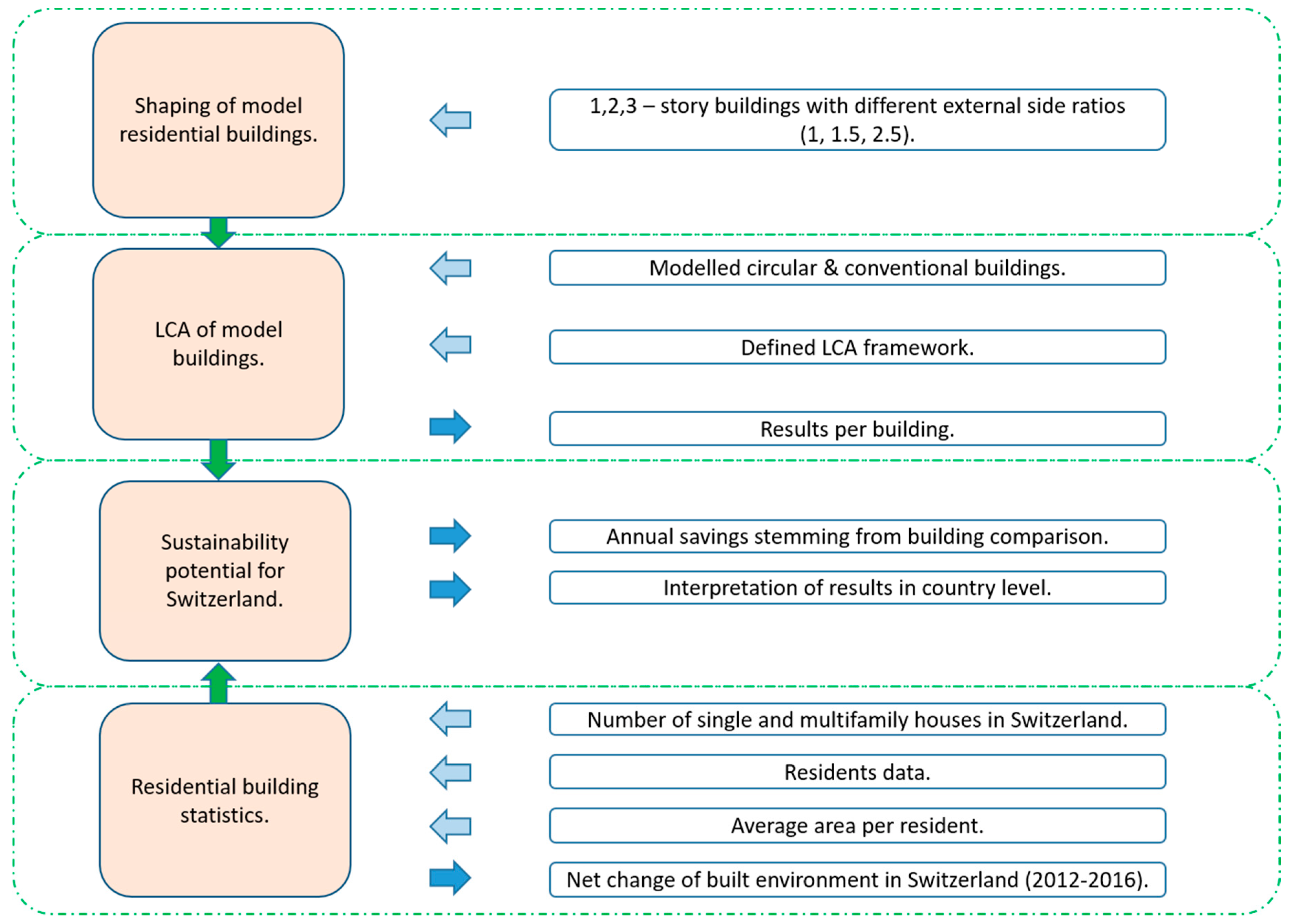
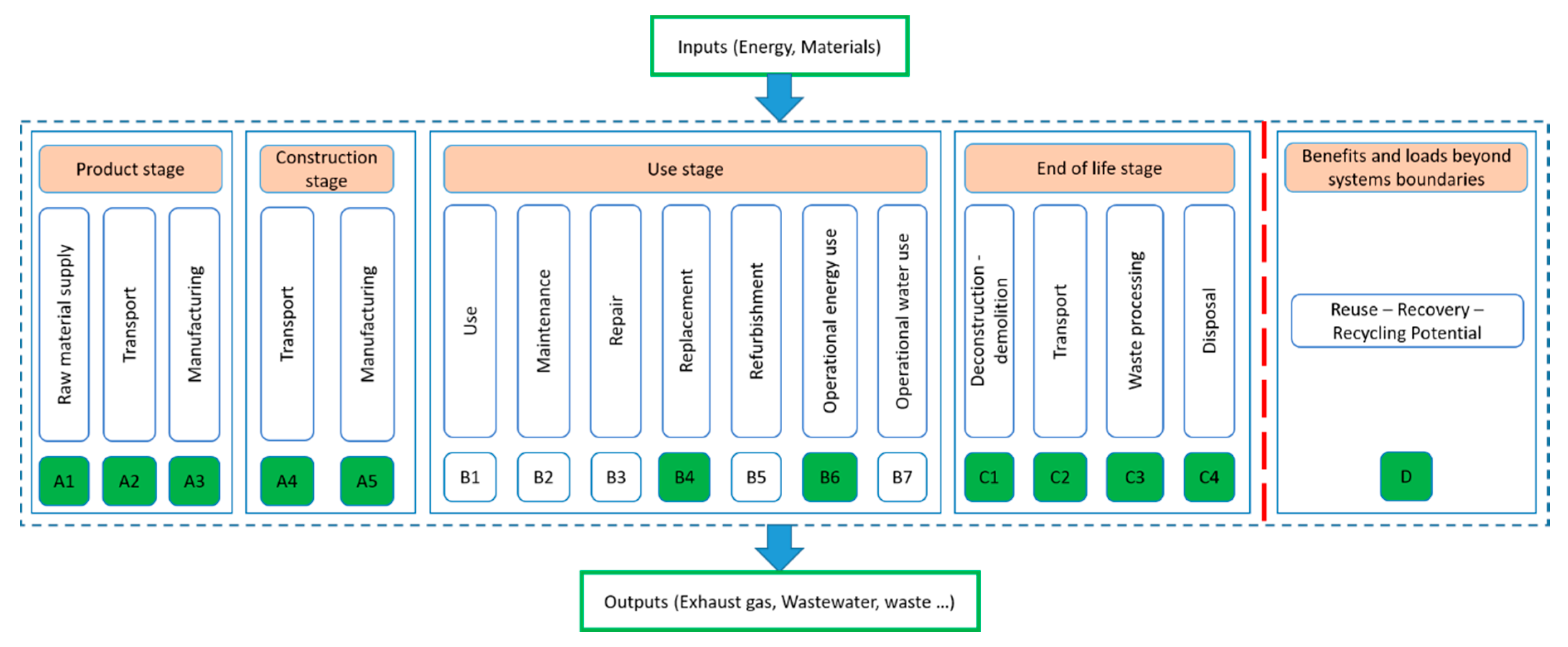
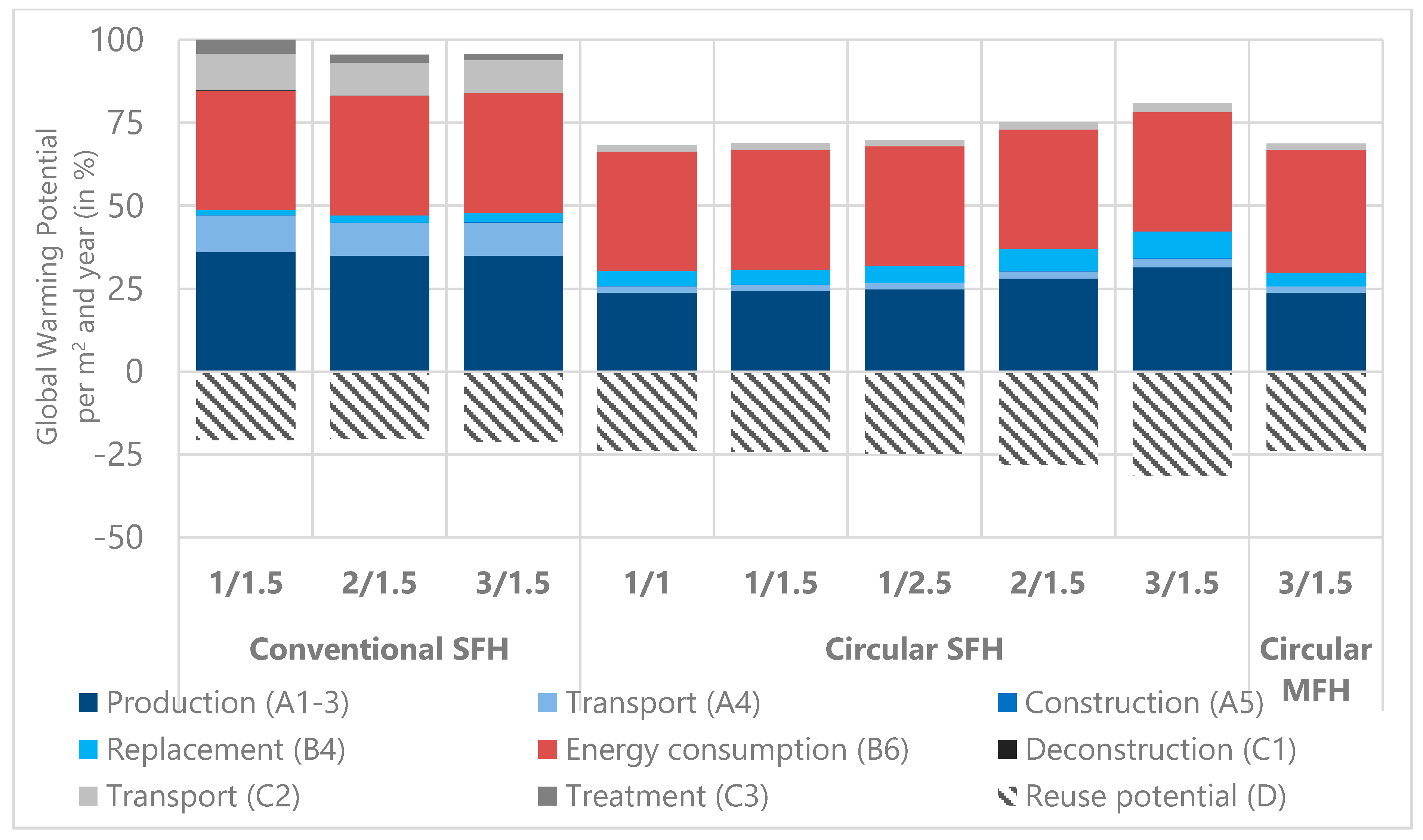
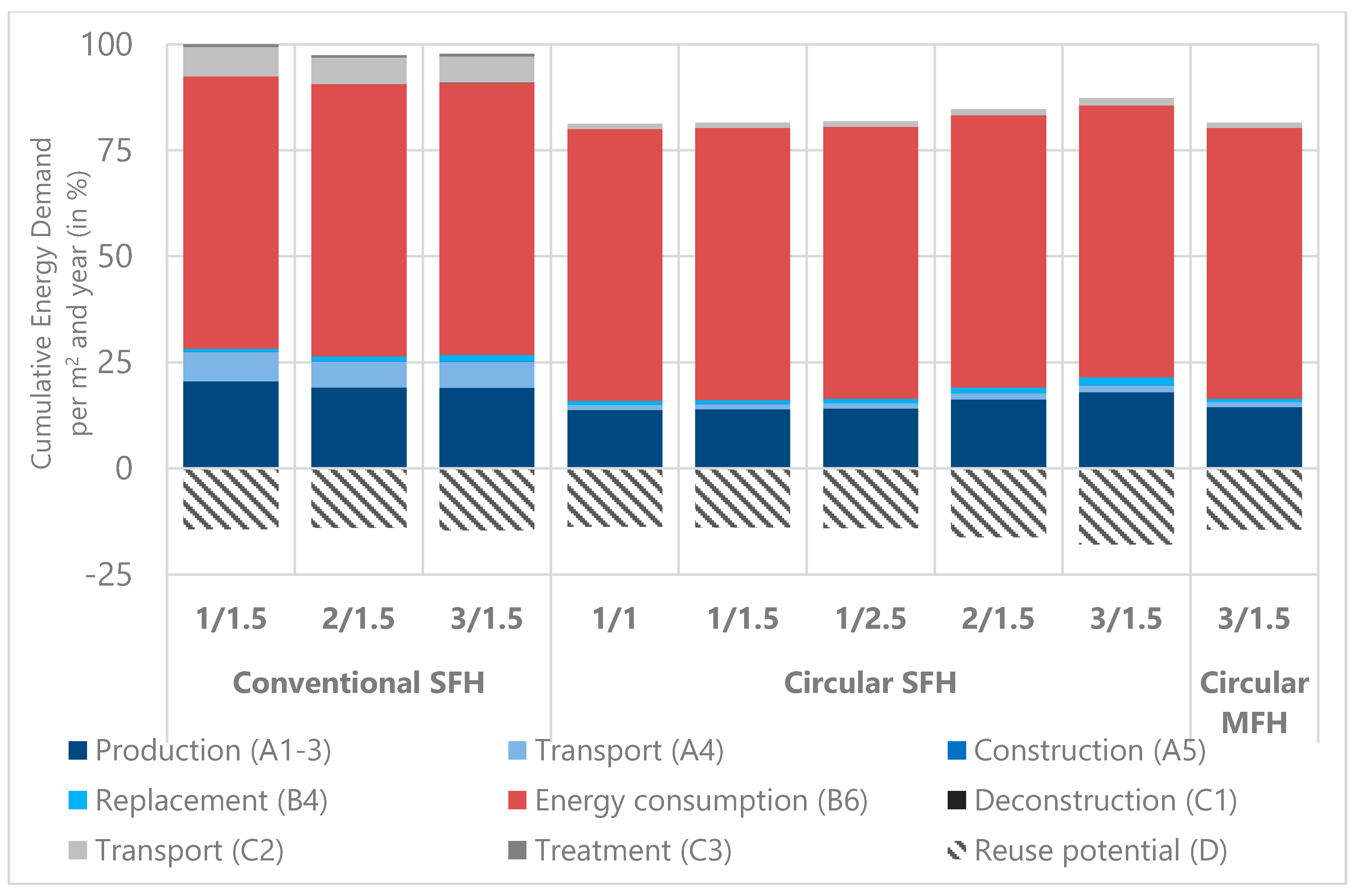
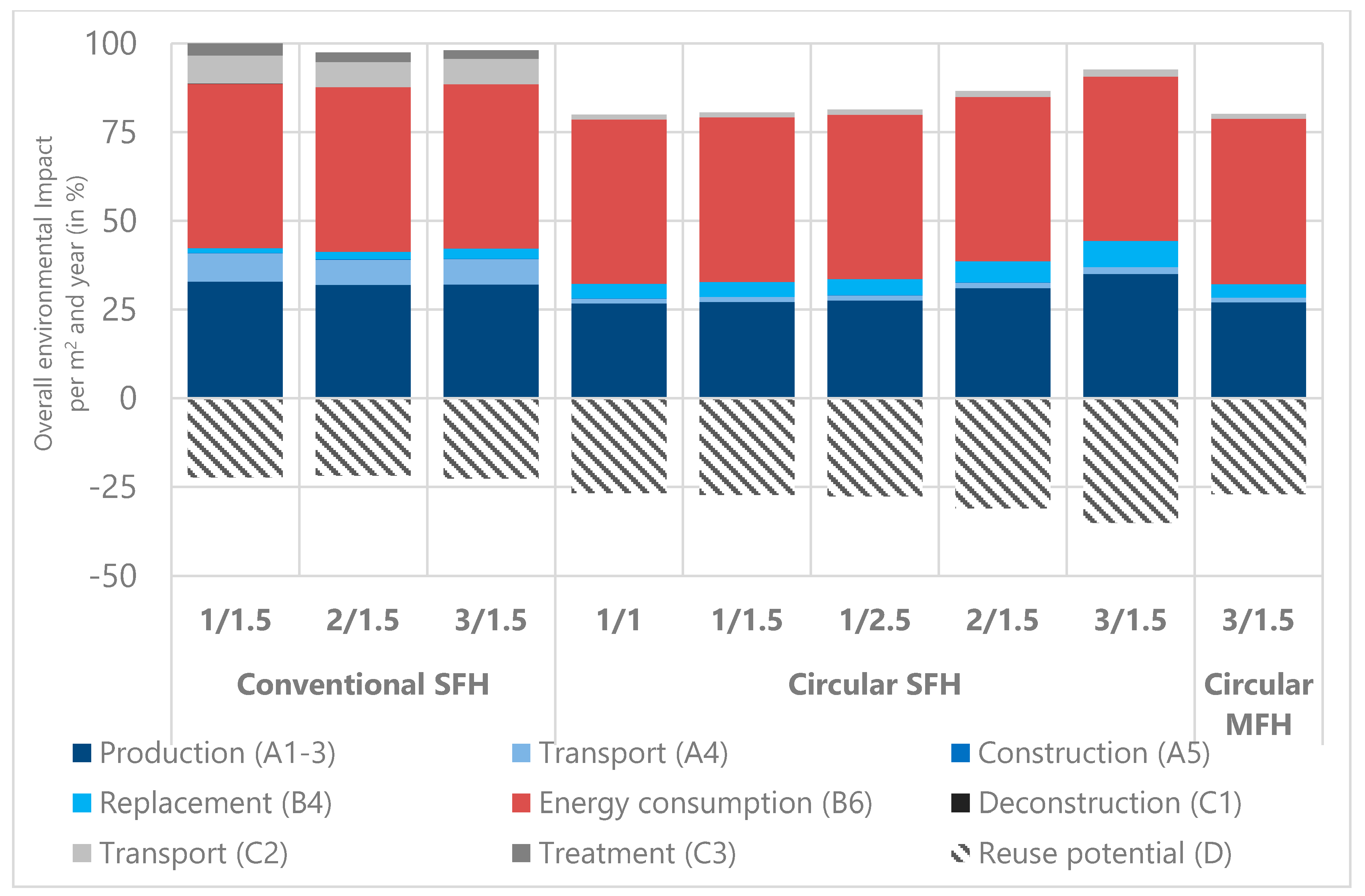
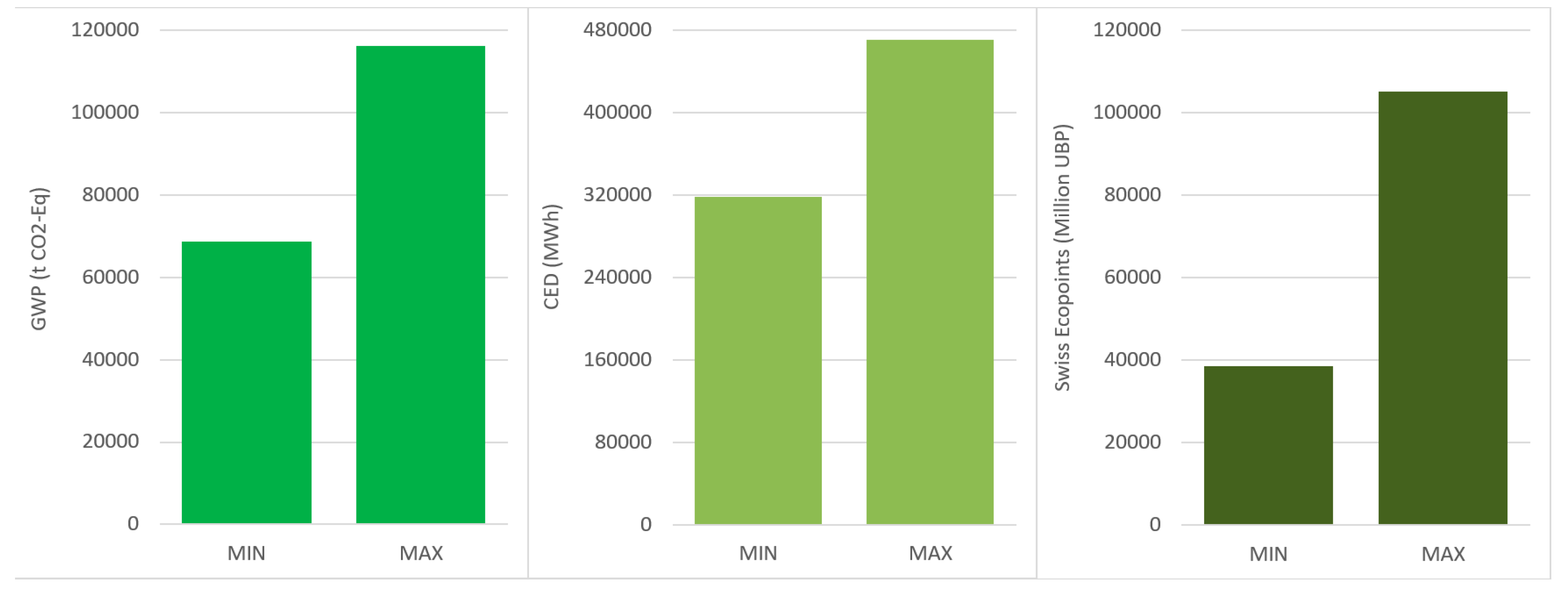
| Number of Floors | 2012 | 2016 | ||||||
|---|---|---|---|---|---|---|---|---|
| Absolute # of Buildings | % of Total | Absolute # of Buildings | % of Total | |||||
| SFH | MFH | SFH | MFH | SFH | MFH | SFH | MFH | |
| 1 | 100,142 | 3453 | 10.41 | <1 | 102,312 | 3853 | 10.34 | <1 |
| 2 | 585,135 | 97,155 | 60.82 | 22.54 | 604,063 | 103,497 | 61.07 | 22.66 |
| 3 | 254,268 | 170,526 | 26.43 | 39.56 | 261,713 | 181,224 | 26.46 | 39.68 |
| 4 | 20,178 | 94,803 | 2.1 | 21.99 | 18,904 | 100,070 | 1.91 | 21.91 |
| 5 | 2126 | 38,467 | 0.22 | 8.92 | 2006 | 40,257 | 0.2 | 8.81 |
| 6 | 125 | 14,112 | 0.01 | 3.27 | 80 | 14,760 | 0.01 | 3.23 |
| 7 | 21 | 6406 | <0.01 | 1.49 | 16 | 6657 | <0.01 | 1.46 |
| 8 | 10 | 2848 | <0.01 | <1 | 4 | 3056 | <0.01 | <1 |
| 9 | 9 | 1346 | <0.01 | <1 | 0 | 1426 | <0.01 | <1 |
| 10+ | 1 | 1919 | <0.01 | <1 | 0 | 1952 | <0.01 | <1 |
| Total | 962,015 | 431,035 | 100 | 100 | 989,098 | 456,752 | 100 | 100 |
| Building Parameters | SFH | MFH | ||||
|---|---|---|---|---|---|---|
| Number of Floors | 1 | 2 | 3 | 3 | ||
| ESR | 1 | 1.5 | 2.5 | 1.5 | 1.5 | 1.5 |
| Area per floor (m2) | 120 | 120 | 120 | 60 | 40 | 150 |
| Length (m) | 10.95 | 13.4 | 17.4 | 9.5 | 7.75 | 15 |
| Width (m) | 10.95 | 8.95 | 6.9 | 6.3 | 5.15 | 10 |
| Swiss (100%) Residential Buildings | Average Area per Resident (m2) | # of Residents | Built Area (km2) | ||||
|---|---|---|---|---|---|---|---|
| 2012 | 2016 | Net Change | 2012 | 2016 | Net Change | ||
| SFH | 51 | 2,246,691 | 2,354,077 | 107,386 | 114.58 | 120.06 | 5.48 |
| MFH | 48 | 4,069,389 | 4,451,085 | 381,696 | 195.33 | 213.65 | 18.32 |
© 2020 by the authors. Licensee MDPI, Basel, Switzerland. This article is an open access article distributed under the terms and conditions of the Creative Commons Attribution (CC BY) license (http://creativecommons.org/licenses/by/4.0/).
Share and Cite
Kakkos, E.; Heisel, F.; Hebel, D.E.; Hischier, R. Towards Urban Mining—Estimating the Potential Environmental Benefits by Applying an Alternative Construction Practice. A Case Study from Switzerland. Sustainability 2020, 12, 5041. https://doi.org/10.3390/su12125041
Kakkos E, Heisel F, Hebel DE, Hischier R. Towards Urban Mining—Estimating the Potential Environmental Benefits by Applying an Alternative Construction Practice. A Case Study from Switzerland. Sustainability. 2020; 12(12):5041. https://doi.org/10.3390/su12125041
Chicago/Turabian StyleKakkos, Efstathios, Felix Heisel, Dirk E. Hebel, and Roland Hischier. 2020. "Towards Urban Mining—Estimating the Potential Environmental Benefits by Applying an Alternative Construction Practice. A Case Study from Switzerland" Sustainability 12, no. 12: 5041. https://doi.org/10.3390/su12125041
APA StyleKakkos, E., Heisel, F., Hebel, D. E., & Hischier, R. (2020). Towards Urban Mining—Estimating the Potential Environmental Benefits by Applying an Alternative Construction Practice. A Case Study from Switzerland. Sustainability, 12(12), 5041. https://doi.org/10.3390/su12125041





